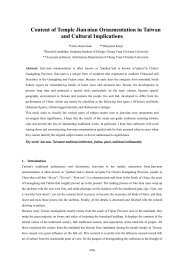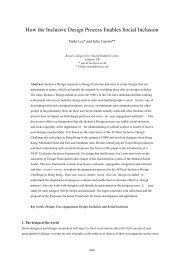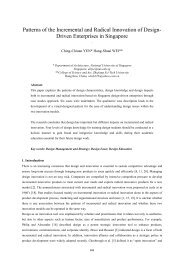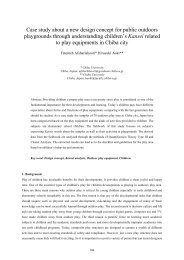Design Orientation: The Antecedents, Research ... - iasdr 2009
Design Orientation: The Antecedents, Research ... - iasdr 2009
Design Orientation: The Antecedents, Research ... - iasdr 2009
Create successful ePaper yourself
Turn your PDF publications into a flip-book with our unique Google optimized e-Paper software.
example, Nike designs products to help consumers engage more fully in the running process and achieve their<br />
running-related goals: smart shoes that track performance and inform runners when they have broken their<br />
personal records (Ramaswamy, 2008). Second, due to intense competition, product performance and price<br />
became less important differentiators. In this new environment, suppliers search for new avenues to differentiate<br />
themselves (Ulaga and Eggert, 2006).<br />
In spite of the fact that product appearance would not seem to be superior to performance, Yamamoto and<br />
Lambert (1994) provide evidence that the appearance of an industrial product may have an impact on its<br />
evaluation. <strong>The</strong> authors show that aesthetic industrial product imposes an influence, which in some<br />
circumstances exceeds the influence of certain product functionality or price attributes. <strong>The</strong>y maintain that the<br />
impact of product appearance affects people in different organizational functions, across a range of technical<br />
orientations (Yamamoto and Lambert, 1994). Acknowledging the importance of other product characteristics,<br />
Orth and Malkewitz’s research on packaging (2008) emphasize the design elements, such as the hourglass shape<br />
of the Coca-Cola bottle and its logo in Spencerian type or the round-shouldered Bordeaux-style wine bottles<br />
(Orth and Malkewitz, 2008). <strong>The</strong> authors (2008) indicate that design elements create a package’s visual<br />
appearance and they become an integral part of a brand’s image. Moreover, Justice (2008) asserts that marketing<br />
and engineering are the primary drivers of innovation. However, what makes satisfy a desire or a need is the<br />
emotional aspect of product “lust”. <strong>The</strong> critical role of the designer is to combine the usability and aesthetics<br />
concepts to achieve a great product by acknowledging the importance of ‘designing for emotion’ (Justice, 2008;<br />
Norman, 2004). Below, Apple demonstrates one of the best examples of how a design driven company can use<br />
design thinking to obtain a sustainable competitive advantage by influencing the consumer behavior through<br />
altering not only the means of distribution but even the ways in which people enjoy and think about music<br />
(Levy, 2006).<br />
IV. <strong>The</strong> <strong>The</strong>oretical Contributions of this <strong>Research</strong><br />
<strong>The</strong> design literature has a particular interest in design’s effect on business performance (Borja, 2007). However,<br />
there is little research done (Gotzsch, 1998) on developing a framework of "<strong>Design</strong> <strong>Orientation</strong>". <strong>The</strong> anecdotal<br />
evidence which lacks clear and comprehensive construct in the literature that captures the key elements of a<br />
design orientation, motivates me to study to address this gap by synthesizing extant knowledge on the subject.<br />
My research also aims to provide a foundation for operationalization of design orientation through establishing<br />
the construct's domain, developing research propositions, and constructing an integrating framework that<br />
includes determinants of a “<strong>Design</strong> <strong>Orientation</strong>”.<br />
V. Purpose of the <strong>Research</strong><br />
<strong>The</strong> proposed research will identify and analyze the nature of a newly emergent construct of “design<br />
orientation”. More specifically, it will develop an understanding of why some firms are more design-oriented<br />
than others and what the role of design in co-creation environment (the inclusion of B2B customer and consumer<br />
into the design process) could be. In particular, my research will: Define the construct of <strong>Design</strong> <strong>Orientation</strong> in a<br />
B2B/B2C setting; Identify the underlying dimensions of <strong>Design</strong> <strong>Orientation</strong>. Specifically it will address the<br />
4260







